Track my order
RESOURCES
Non-Standard Specialty Shipping Container Guide: Open-Side, Side-Door, Tunnel Containers & More



What’s the first thought that comes to your mind when you hear “shipping container”? A simple, standardized, steel box used to transport goods, right? Guess what: There’s a world of specialty containers designed for specific business needs that literally make light of your heavy goods.
From bulky construction materials to delicate machinery, specialty containers are purpose-built to solve logistical challenges that standard cargo containers just can’t handle.
In this comprehensive specialty shipping container guide, we’ll dive into six of the most popular options, telling you what they do, why they’re awesome, how you can modify them and how they can make your business life a whole lot easier.
(Need even more guidance on buying shipping containers? Reach out to our team of container specialists at any time.)
But First: What’s a Standard Shipping Container?
Shipping containers are critical links in the global supply chain. They come in standard sizes of 20 feet or 40 feet length, 8 feet width, and 8.6ft height (9.6ft for high-cubes) as set by the International Organization for Standardization (ISO). These standardizations ensure they seamlessly fit on ships, trains, and trucks, making it super efficient and cost-effective to move goods around the globe.
Standard containers are incredibly versatile, capable of transporting products from electronics and clothing to furniture and machinery. But while standard freight containers are great for most shipping needs, there are times when you need something more specific, like a wider opening or additional access points. That's where specialty containers come into play. These containers are specially designed for cargo that doesn’t fit into standard containers.
Are you curious to know what’s on offer at Boxhub? Learn more.
Here are some of the most common specialty containers:
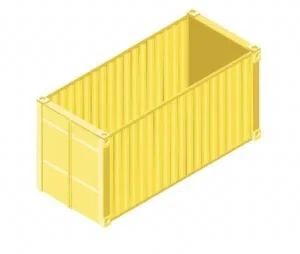
These have a removable roof, perfect for loading and unloading bulky items like machinery.

Featuring doors at both ends, these containers make loading and unloading quicker and more efficient.

These are shorter than standard ISO containers, designed for transporting heavy, dense cargo like coal, rocks, or minerals

These have big, sliding doors on one side that give full access to heavy, bulky goods.
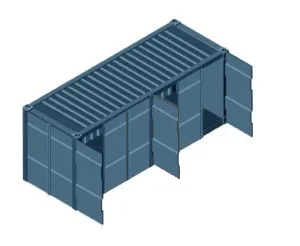
These have multiple doors on the side, making it easier to load and unload cargo rapidly

With collapsible sides, these are ideal for heavy or oversized cargo.
Let’s dive into each specialty container's features, applications, and best use cases.
Detailed Breakdown of Specialty Containers
Side-Door Containers

Side-door containers feature additional hinged doors along their length, offering more flexible access to their contents. These containers have two or four doors on the side, so you can load and unload goods from different angles. They come in two sizes: 20 feet and 40 feet. Plus, they're built with strong steel frames and follow the International Organization for Standardization (ISO) rules for shipping containers, so you can use them anywhere in the world.
Got a bunch of stuff that's just too bulky for a regular storage container? Or maybe you need easy access to your gear without a fancy loading dock? Well, side-door containers might just be the answer. These specialty containers are perfect for businesses that need to set up shop on the fly. Imagine a trade show booth that's ready to go in minutes, thanks to those handy side doors. And when the show's over, you can lock everything up tight and hit the road. You can even add partitions to create distinct storage units. Side-door containers are your ideal multi-unit storage space or a pop-up shop.
Used 20-foot side-door containers typically start at around $3,000, while new (one-trip) 20-foot side-door containers start at $6,000—though prices can vary based on condition and location.
Prefer a DIY alternative to side-door containers? Read on to discover how to create a DIY side-door container in this article.
Who Uses Side-Door Containers?
• Side-door containers are perfect for businesses needing quick and flexible loading options, especially for large, awkwardly shaped goods like machinery or equipment that can’t be loaded through standard doors.
• Side doors are useful in industries where users need frequent access to cargo from multiple points, such as events, exhibitions, and logistics for machinery transport.
• With side door containers, managing cargo is really easy and functional—items can be loaded and unloaded much faster as compared to a standard ISO container.
Beyond shipping, side door containers are popularly (and uniquely) converted into pop-up retail stores, offices, cafes, and more. They’re also widely seen at festivals and events as they provide a robust and economical alternative to event tents with minimal set-up.
Side-Door Container Dimensions
Specifications
20ft Side-Door
40ft Side-Door
External Dimensions (L x W x H)
20ft x 8ft x 8.5ft
40ft x 8ft x 8.5ft
Internal Dimensions (L x W x H)
19.3ft x 7.75ft x 7.8ft
39.5ft x 7.75ft x 7.8ft
Door Opening (Side) (W x H)
18ft x 7.5ft
39.2ft x 7.5ft
Cubic Capacity (ft³)
1,165ft³
2,358.5ft³
Max Gross Weight (lbs)
67,205 lbs
67,205 lbs
Tare Weight (lbs)
6,063 lbs
10,353 lbs
Payload Capacity (lbs)
56,866 lbs
61,666 lbs
Open-Side Containers

Open-side containers have one entire side that opens, allowing for full-width loading and unloading. This makes them ideal for storing bulky or oversized items that would be difficult to fit through regular container doors. They're designed to work seamlessly with forklifts, making it easy to move items in and out without any hassle.
Available in two standard sizes (20-foot and 40-foot), these multi-door shipping containers are built to last, with a reinforced steel structure that ensures stability despite the large opening. Another key feature of such side open shipping containers is the ventilation, which helps to transport goods that are sensitive to temperature or humidity.
Open-side containers are invaluable for businesses handling bulky cargo, such as large pieces of furniture, machinery, or construction gear that can’t easily be loaded into a regular container. Imagine trying to squeeze a giraffe into a phone booth… Yep, that’s why construction companies love open-side containers! Loading large equipment like scaffolding can be a breeze.
If you need to load or unload quickly, or access the conex’s entire contents via the whole wide side of the container, these are your best bet. Also known as ‘ventilated containers’, open-side storage containers are great for storing stuff that needs to breathe, like fresh produce.
Used 20-foot open-side containers typically start around $4,000, while new (one-trip) 20-foot open-side containers can start at $7,000. As with any container, prices can vary significantly based on condition, location, and market demand. To find which of these two will be a better fit for your specific requirements, speak to a container specialist.
Open-Side Container Dimensions
Specifications
20ft Open-Side
40ft Open-Side
External Dimensions (L x W x H)
20ft x 8ft x 8.5ft
40ft x 8ft x 8.5ft
Internal Dimensions (L x W x H)
19.3ft x 7.75ft x 7.8ft
39.5ft x 7.75ft x 7.8ft
Door Opening (Side) (W x H)
19.1ft x 7.5ft
38.4ft x 7.5ft
Cubic Capacity (ft³)
1,152.2ft³
2,397.1ft³
Max Gross Weight (lbs)
67,205 lbs
71,650 lbs
Tare Weight (lbs)
6,392 lbs
10,610 lbs
Payload Capacity (lbs)
60,813 lbs
61,040 lbs
Open-Top Containers
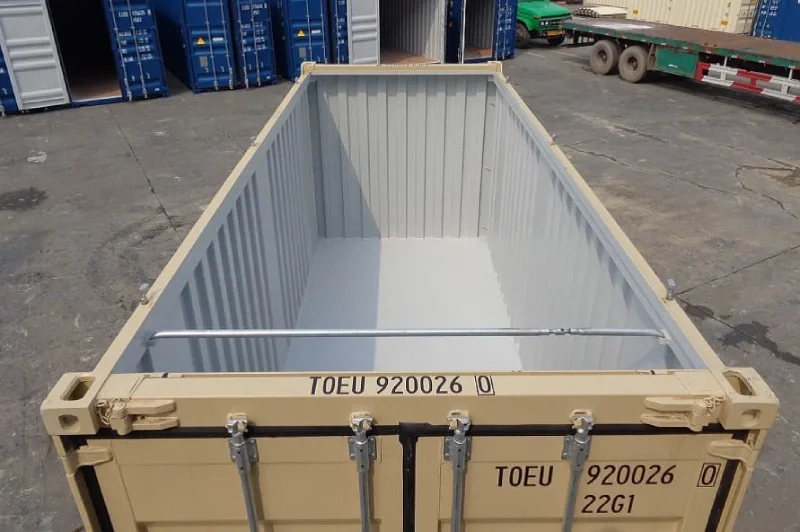
Open-top shipping containers feature a removable roof, typically made from tarpaulin, that allows cargo to be loaded from above. This is useful for tall or awkwardly shaped items that won’t fit through a standard container’s doors.
Open-top containers are like a roofless storage unit that makes top-loading easy. They're built tough with strong sidewalls and a reinforced floor to handle heavy cargo. They come with lashing rings and a sturdy tarp to keep the goods dry and protected. You can get them in different sizes, including tall versions for extra space.
Imagine loading giant steel beams from the top with a crane, like a real-life game of Tetris. Open-top containers are like the open-air express for cargo that's too tall for regular containers. The beams can be loaded from the top using a crane and securely covered with a tarp for transport, ideal for industries like construction, mining, and scrap metal, where irregular cargo sizes need vertical loading.
Used 20-foot open-top containers typically start around $4,000, while new (one-trip) 20-foot open-top containers can start at $6000. And yes, you guessed it: prices will vary significantly based on condition, location, and market demand.
Open-Top Container Dimensions
Specifications
20ft Open-Top
40ft Open-Top
External Dimensions (L x W x H)
20ft x 8ft x 8.5ft
40ft x 8ft x 8.5ft
Internal Dimensions (L x W x H)
19.3ft x 7.7ft x 7.7ft
39.5ft x 7.7ft x 7.7ft
Cubic Capacity (ft³)
1,151.2ft³
2,342.5ft³
Max Gross Weight (lbs)
52,910 lbs
67,205 lbs
Tare Weight (lbs)
5,071 lbs
8,378 lbs
Payload Capacity (lbs)
47,639 lbs
58,827 lbs
Flat Rack Containers
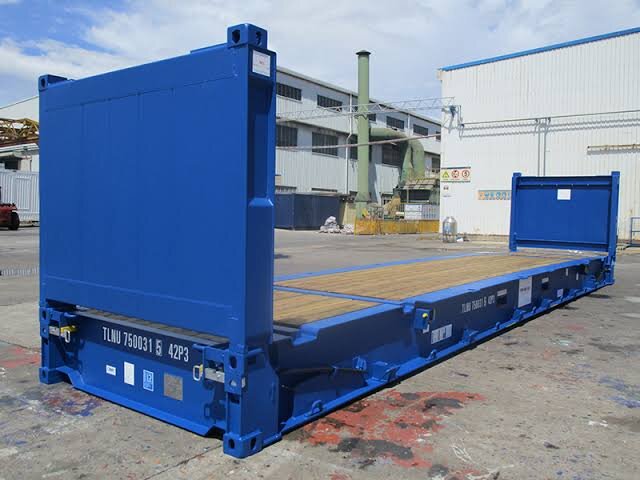
Flat rack shipping containers have no side walls, and sometimes no end walls, providing an open structure for shipping large or unusually shaped items. They are reinforced to handle heavy loads, making them a go-to solution for oversized cargo.
These containers are like a flexible storage solution. They have walls that can be folded down or stay up, making it easy to load big, bulky goods. The strong frame of 20ft flat rack containers and 40ft flat rack containers can hold everything in place with special rings to tie down your cargo securely.
Flat rack containers are like the big rigs of the container world, making it easy to ship heavy-duty goods like cars, machinery, steel beams, pipes, or large, bulky parts that can’t be contained within a standard shipping container—like wind turbine blades.
20-foot used flat-rack containers typically start at around $5,000, although prices can vary significantly based on several factors.
Flat Rack Container Dimensions
Specifications
20ft Flat Rack
40ft Flat Rack
External Dimensions (L x W x H)
20ft x 8ft x 7.4ft
40ft x 8ft x 7ft
Internal Dimensions (L x W x H)
18.5ft x 7.2ft x 7.1ft
39.8ft x 7.2ft x 6.4ft
Max Gross Weight (lbs)
74,957 lbs
99,208 lbs
Tare Weight (lbs)
6,036 lbs
11,023 lbs
Payload Capacity (lbs)
68,921 lbs
88,185lbs
Double-Door (Tunnel) Containers
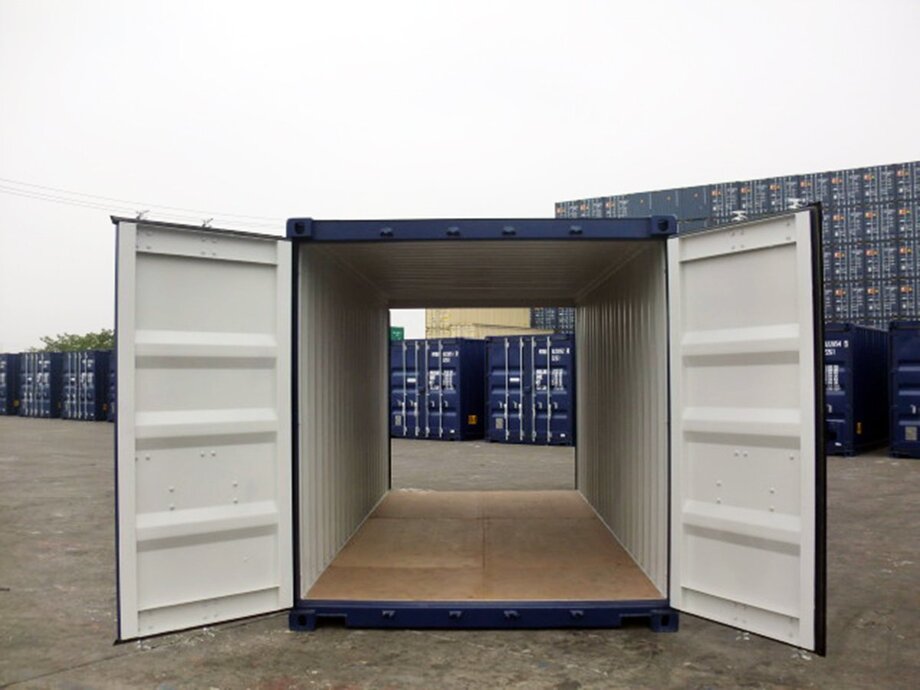
Double-door containers feature doors at both ends, making loading and unloading significantly faster and more efficient. This design is ideal for businesses that require quick access to long, fragile goods or need to load cargo from both ends simultaneously.
Industries that transport long, delicate items like glass or artwork frequently use double-door containers. For example, a glass manufacturer could load long glass panels from one end of the container and unload them at the other, without worrying about them getting scratched or broken. Or, a motorcycle manufacturer might use double-door containers to load bikes from one side and unload them easily at the destination, ensuring minimal handling damage.
Double-door storage containers are like having a storage unit with two entrances. You can even divide the container into two sections, making it perfect for creating two distinct spaces within one container—or even setting up a little office or shop inside. They are a more cost-effective way to modify and get creative with containers. You can make anything from public walkways to office hallways by connecting two or more double-door containers.
A new (one-trip) 20ft double-door container starts at $3,250. Want to make a cheaper, do-it-yourself alternative to a double-door container? You can learn how to make a DIY double-door container below.
Double-Door (Tunnel) Container Dimensions
Specifications
20ft Double-Door
40ft Double-Door
External Dimensions (L x W x H)
20ft x 8ft x 8.5ft
40ft x 8ft x 8.5ft
Internal Dimensions (L x W x H)
19.3ft x 7.7ft x 7.8ft
39.5ft x 7.7ft x 7.8ft
Cubic Capacity (ft³)
1,173.5ft³
2,390.6ft³
Max Gross Weight (lbs)
67,205 lbs
71,650 lbs
Tare Weight (lbs)
6,293 lbs
8,598 lbs
Payload Capacity (lbs)
60,912 lbs
63,052 lbs
Half-Height Containers

As the name suggests, half-height shipping containers are shorter than standard containers. Designed for transporting heavy, dense cargo like coal, rocks, or minerals, half-height containers are most often used in the mining, offshore, and construction industries.
They're often roofless or have hatches on top, making them perfect for loading heavy items directly from cranes or forklifts. Their shorter height often means they have no roof or only small hatches, allowing for easy top loading. This makes half-height containers perfect for industries that deal with heavy or bulky items that need to be loaded from above.
Additionally, half-height containers can be stacked on top of each other, maximizing cargo capacity in a limited space. A mining company might use half-height containers to transport large quantities of minerals cost-effectively from the mining site to processing facilities.
Prices for 20ft new half-height containers start at approximately $4,500. Not sure what specialty shipping container is right for your business? Talk to our expert team to find out.
Half-Height Container Dimensions
Specifications
20ft Half-Height
External Dimensions (L x W x H)
20ft x 8ft x 4.3ft
Internal Dimensions (L x W x H)
19.4ft x 7.7ft x 3.7ft
Cubic Capacity (ft³)
558.7ft³
Max Gross Weight (lbs)
67,205 lbs
Tare Weight (lbs)
6,499 lbs
Payload Capacity (lbs)
60,800 lbs
Comparing Similar Specialty Containers
Some containers seem so similar, you may be wondering what sets them apart.
When choosing between side-door and open-side containers, consider your specific needs.
- Side-door containers are perfect if you need flexible access to some areas of the container without needing the entire side to open. This is ideal for items that require more controlled loading or unloading, or if you want to protect specific parts of your cargo from the elements. You can even implement partitioning to create distinct spaces within the container.
- Open-side containers, on the other hand, are best for quick, full-width access to the container's interior. This is particularly useful for forklift loading or unloading large, bulky items. If you need to quickly load or unload cargo without any obstructions, an open-side container is the way to go.
In short, choose side-door containers for more controlled access and open-side containers for faster, large-scale loading.
For businesses that can’t decide between open-top and flat-rack containers we recommend the following:
- Open-top containers are ideal for tall cargo that still needs some protection from nature. They offer the flexibility of top loading while providing walls and a removable roof that protect your goods from rain, snow, or other weather conditions. This makes them suitable for items that are sensitive to the weather or that need to be loaded or unloaded from above.
- Flat-rack containers are best for oversized cargo that doesn't need the ongoing protection of side or top walls. They offer a completely open space, allowing you to load and unload cargo from any side, making them ideal for extremely large or heavy items that need to be transported without any restrictions.
We recommend you use open-top containers for goods with height that also need protection from the weather, and flat-rack containers for transporting bulky, heavy-duty loads.

Why Are Specialty Containers More Expensive?
Factors like size, type, condition, and delivery location influence the price of every shipping container. When it comes to specialty containers, two additional factors play an important role: rarity and modifications. As there are fewer specialty containers than standard containers on the market, their prices are usually slightly higher. Modification and customization add to the price of specialty containers as well.
They are often modified or custom-built, requiring additional labor and manufacturing efforts that increase costs. Unique features and construction details—such as reinforced materials, removable roofs, or collapsible sides—add to the expense due to specialized production processes and limited manufacturing runs.
Specialty Container Alternatives
For businesses on a budget, modifying a standard sea container can be a cost-effective alternative to purchasing a specialty unit—with the same great results. With a little imagination (and welding), side-door and double-door containers can be easily replicated by installing a standard conex with steel man-doors or roll-up doors.
• Steel man-doors typically come in various sizes, with features like double bores for security and durable steel framing.
• Roll-up doors, also made from steel, come in different widths to replace ISO doors, end walls, or side walls in both standard and high-cube containers.
These DIY alternatives provide clear cost savings—but they also provide you with full control over your container’s configuration. By modifying a standard container, businesses can create versatile spaces for storage, workshops, or other purposes while avoiding the larger price tag of an “out-of-the-box” specialty container.


Find Your Specialty Container on Boxhub
Now you know, specialty containers aren’t just boxes; they're logistical powerhouses! They can help you stand out, keep your products safe during shipping, and even boost your brand image.
At Boxhub, we help thousands of businesses make the right buying decisions when it comes to specialty containers. Whether you need new shipping containers or have very unique needs for your business, we've got you covered.
Browse through our online catalog of specialty containers or reach out to our container experts for a personal consultation over the phone. We’re happy to guide you through the world of specialty containers.
A flat rack container is ideal for oversized cargo that doesn’t need side or top walls, such as heavy machinery or large vehicles. It offers open access for loading from the sides or top. An open top container, on the other hand, is best for tall or irregularly shaped cargo that requires top-loading and still needs protection from the elements with a removable roof.
A high cube shipping container is a type of container that is similar to standard containers but with extra height. The height of a high cube container is 9.6ft, which is one foot taller than the standard container height of 8.6ft, providing additional vertical space for taller cargo.
An open top container is a type of shipping container with a removable roof, allowing cargo to be loaded from the top. This makes it suitable for tall or irregularly shaped cargo that can’t be loaded through standard container doors.

About Hannah Swinkin
Hannah is a B2B marketing leader with a passion for container upcycling projects and cargotecture. She sharpened her marketing expertise at disruptive tech companies transforming antiquated industries, including shipping, parking, and commercial real estate.







Continue Shopping
Loading cart